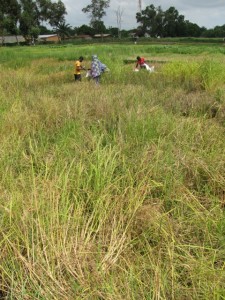 Some of you may have been wondering where I’d got to, a few weeks back. No? Nobody missed me at all? Well, I’ll tell you anyway. I was on a quick tour of West Africa, visiting the genebanks of IITA, NACGRAB (both around Ibadan in Nigeria) and AfricaRice (just outside Cotonou, Benin; its experimental fields are illustrated here to the left). It’s all in the context of the CGIAR’s new Research Programme on Genebanks. We were trying to work out the best way for the CGIAR as a system to provide an efficient and cost-effective service in long-term ex situ conservation of rice genetic resources in Africa, and indeed the rest of the world, given that three Centres have an interest in the subject. Below you’ll see the peregrinations our merry band undertook (thanks to Ruaraidh and his GPS receiver). I think you’ll have to click on the link and go to Google Maps to see the full extent of the trip. All great fun. And, I think, quite successful. I’ll post a link to the resulting document when it’s all finally agreed.
Some of you may have been wondering where I’d got to, a few weeks back. No? Nobody missed me at all? Well, I’ll tell you anyway. I was on a quick tour of West Africa, visiting the genebanks of IITA, NACGRAB (both around Ibadan in Nigeria) and AfricaRice (just outside Cotonou, Benin; its experimental fields are illustrated here to the left). It’s all in the context of the CGIAR’s new Research Programme on Genebanks. We were trying to work out the best way for the CGIAR as a system to provide an efficient and cost-effective service in long-term ex situ conservation of rice genetic resources in Africa, and indeed the rest of the world, given that three Centres have an interest in the subject. Below you’ll see the peregrinations our merry band undertook (thanks to Ruaraidh and his GPS receiver). I think you’ll have to click on the link and go to Google Maps to see the full extent of the trip. All great fun. And, I think, quite successful. I’ll post a link to the resulting document when it’s all finally agreed.
View IITA & AfricaRice in a larger map